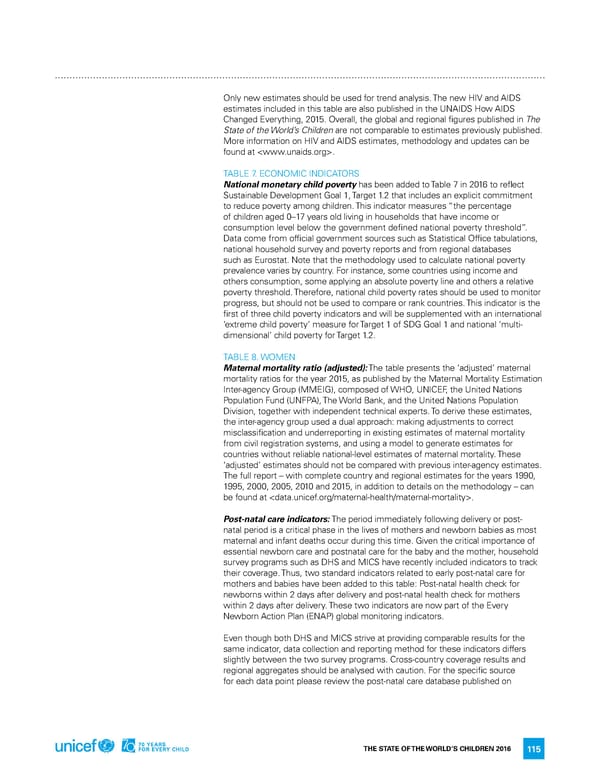Only new estimates should be used for trend analysis. The new HIV and AIDS estimates included in this table are also published in the UNAIDS How AIDS Changed Everything, 2015. Overall, the global and regional figures published in The State of the World’s Children are not comparable to estimates previously published. More information on HIV and AIDS estimates, methodology and updates can be found at . TABLE 7. ECONOMIC INDICATORS National monetary child poverty has been added to Table 7 in 2016 to reflect Sustainable Development Goal 1, Target 1.2 that includes an explicit commitment to reduce poverty among children. This indicator measures “the percentage of children aged 0–17 years old living in households that have income or consumption level below the government defined national poverty threshold” . Data come from official government sources such as Statistical Office tabulations, national household survey and poverty reports and from regional databases such as Eurostat. Note that the methodology used to calculate national poverty prevalence varies by country. For instance, some countries using income and others consumption, some applying an absolute poverty line and others a relative poverty threshold. Therefore, national child poverty rates should be used to monitor progress, but should not be used to compare or rank countries. This indicator is the first of three child poverty indicators and will be supplemented with an international ‘extreme child poverty’ measure for Target 1 of SDG Goal 1 and national ‘multi- dimensional’ child poverty for Target 1.2. TABLE 8. WOMEN Maternal mortality ratio (adjusted): The table presents the ‘adjusted’ maternal mortality ratios for the year 2015, as published by the Maternal Mortality Estimation Inter-agency Group (MMEIG), composed of WHO, UNICEF, the United Nations Population Fund (UNFPA), The World Bank, and the United Nations Population Division, together with independent technical experts. To derive these estimates, the inter-agency group used a dual approach: making adjustments to correct misclassification and underreporting in existing estimates of maternal mortality from civil registration systems, and using a model to generate estimates for countries without reliable national-level estimates of maternal mortality. These ‘adjusted’ estimates should not be compared with previous inter-agency estimates. The full report – with complete country and regional estimates for the years 1990, 1995, 2000, 2005, 2010 and 2015, in addition to details on the methodology – can be found at . Post-natal care indicators: The period immediately following delivery or post- natal period is a critical phase in the lives of mothers and newborn babies as most maternal and infant deaths occur during this time. Given the critical importance of essential newborn care and postnatal care for the baby and the mother, household survey programs such as DHS and MICS have recently included indicators to track their coverage. Thus, two standard indicators related to early post-natal care for mothers and babies have been added to this table: Post-natal health check for newborns within 2 days after delivery and post-natal health check for mothers within 2 days after delivery. These two indicators are now part of the Every Newborn Action Plan (ENAP) global monitoring indicators. Even though both DHS and MICS strive at providing comparable results for the same indicator, data collection and reporting method for these indicators differs slightly between the two survey programs. Cross-country coverage results and regional aggregates should be analysed with caution. For the specific source for each data point please review the post-natal care database published on THE STATE OF THE WORLD’S CHILDREN 2016 115
 70 Years for Every Child Page 133 Page 135
70 Years for Every Child Page 133 Page 135